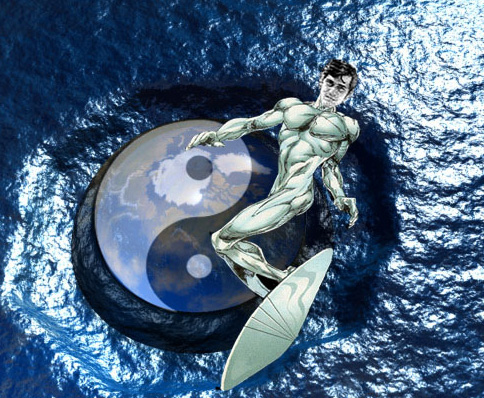I thought about a bundt mold years ago and disregarded the shape, primarily because it wasn't smooth and I thought an angel-food cake pan showed more promise. But the more I thought about it, the more obsessed I got with the shape and began to consider the decorative ridges going from the outside edge to the open center might actually help to structure the energy flow in that unique wrap around way only a powered up orgonite toroid can do.
While still talking and ranting about shapes and energy flow, part of my mind was doing an on-hand inventory of the materials needed for this project.
...bla, bla, bla, cascading densities...
round cake pan, check.
...bla, bla, bla, mobius coil, maybe 24 gauge...
I still have that extra gallon of resin I bought last month, check.
...It's the shape, man. That toroid shape that makes it happen!...
There's a spool of wire in the back room next to the pyramid molds, check.
...And those ridges that go from large on the outside to small on the inside should direct all that energy to the business end, the center vortex, baby!...
I know I saw a bundt cake pan in Kmart for under ten bucks. Iron oxide, powdered copper, vasoline, check, check, check.
I couldn't wait to start. And just as expected, the project was a sloppy, disorganized, chaotic, improvisational mess from start to finish. Yeah, I make orgonite like I cook. A pinch of this, a handful of that, a few last minute changes, some gravy stains, and a surprise every time.
This project was no exception.
This aint your regular bundt cake form. This unit has a bottom half equal in mass to the top half and it took just short of two gallons of resin to produce. The center of this thing is made from a thick slurry of polyester resin, black iron oxide and copper in a 6:1 ratio, some sand, and an internal mobius coil made from 100' of 24 gauge insulated solid copper wire. The second layer is medium density orgonite made with a half teaspoon of black iron oxide, brass shavings, resin, sand, and about a dozen small DT quarts crystals around the perimeter.
Kinda looks like a pumpkin, don't it? If you can come up with a better name than punkin 1 I'm all ears.
You probably noticed a few light discolorations around the hemisphere and part way in the vortex. Those used to be voids where the two hemispheres didn't quite form properly or where the resin cured too fast and produced cracks.
It happens. The temps were in the mid 60's, there was lots of sand and powdered metals in the mix, and lots of resin poured at once, making this project much harder than I anticipated. It doesn't help that this was my first big pour since last fall and I didn't have my act half together for something like this.
But, what the hell. If everything was easy, we'd never learn anything. In this case, I learned plenty.
Before I made any repairs to the voids I hooked up frequency and fired this thing up. Twenty minutes later it just sat there, dead as a doornail. Well, THAT sucks! It took me a couple days and gallons of resin to produce a boat anchor. And an ugly boat anchor, at that.
BUT... (Yeah, I know that's a big but. Everybody's got a big but, ok?) At least I get to see if my edge theory works with a practical demonstration comparing a unit with a sharp edged bunch of voids with the same unit free from any kind of surface imperfections. Some Bondo applied with a Popsicle stick and cleaned up with a dremel restored it's form. I topped it off with a few coats of shellac as a sealant and organic layer and fired it up eight hours later.
 It took about two minutes to charge up before I began to feel the energy field forming around this unit. The smooth shape let the energy envelope the unit and concentrate in the hourglass shaped center vortex.
It took about two minutes to charge up before I began to feel the energy field forming around this unit. The smooth shape let the energy envelope the unit and concentrate in the hourglass shaped center vortex. Unlike the other units I built, this one doesn't need a central core to put out the energy. It runs great all by itself but way better with a big ass crystal. It also does a good job supercharging orgonite and seems to display some pretty awesome manifestation capabilities.
Be that as it may, I still made plenty of mistakes. This prototype may not be as kick-ass as I would like but I can use this unit as a learning tool.
For one, the inner core mass should have been more proportional to the medium density mass surrounding it, making it smaller and more powerful.
Another thing that's been on my mind is the placement of the densities. Do these units have to be extra high density in the center surrounded by progressively lower density orgonite? What if the mobius coil fired up a medium density inner core that stimulated the extra high density material surrounding around it?
The pulsar I built earlier had the extra high density stuff on top to direct the energy flow like a laser. Wouldn't a torus shaped unit like this be more like a hyper-dimensional, non-linear, inside out laser with the surface as the business end with the heaviest concentration in the center vortex?
Looks like the only way to find out is to build a punkin 2.
I'll keep ya posted.



No comments:
Post a Comment